Editions
NTAA’25 (2025)
The 2025 edition of the New Technological Art Award was on view at Zebrastraat in Ghent from February 20 to June 8.
NTAA’22 (2022)
The New Technological Art Award 2022 exhibition took place from february 5th to march 13th in Zebrastraat, Ghent.
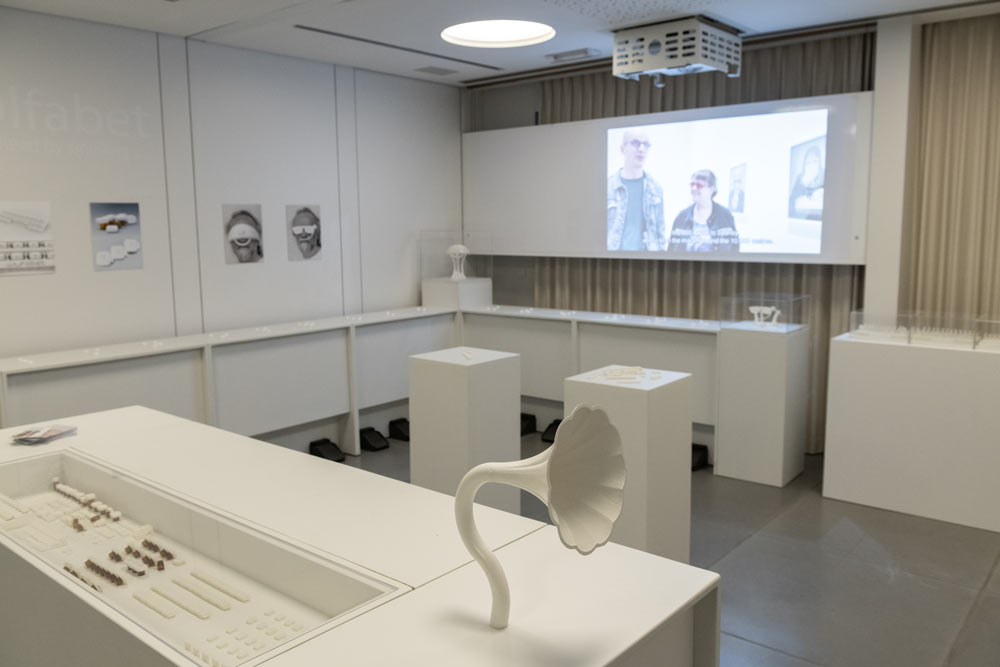
The award ceremony of NTAA’22 took place in Zebrastraat on Saturday evening, March 12. 836 candidates from 72 different countries registered for the international competition - New Technological Art Award. From these entries, an international jury selected 20 nominees:
Haseeb Ahmed (US/BE) – Stock Weather (2020)
Bull.Miletic (NO) – Ferriscope (1893 – 2020) (2020)
Peter Burr (US) – Dirtscraper (2020)
Peter de Cupere (BE) – Olfabet (2021)
Félicie d’Estienne d’Orves (FR) – Martian Sun Series (2019)
Şölen Kıratlı (TR/US), Hannen Wolfe (US), Alex Bundy (US) – Cacophonic Choir ( 2019)
Egor Kraft (RU/AT) – Content Aware Studies Series (2020)
LarbitsSisters (BE) – Crypto Miner Car (2021)
Carolin Liebl & Nikolas Schmid-Pfähler (DE) – RE:PLACES (2021)
Felix Luque Sánchez (SP /BE) – Perpetuité I (2021)
Julian Palacz (AT) – Handle with Care (2021)
Giacomo Piazzi & Matthias Pitscher – The Chiromancer (2020)
Tivon Rice (US) – Models For Environmental Literacy (2020)
Irakli Sabekia (GE) – Voicing Borders (2019)
Theresa Schubert (DE) – mEat me (2020)
Ling Tan (UK) – Playing Democracy (2020)
Timothy Thomasson (CA) – Slow Track (2021)
Nathan Thompson, Guy Ben-Ary, Sebastian Diecke ( AU) – Bricolage (2020)
Jeroen van Loon (NL) – Permanent Data (2020)
::vtol:: (RU) – Floating Point Number (2019)
The audience award went to Olfabet by Peter De Cupere:
Olfabet is a scent alphabet, to read words and texts with scents. By linking specific smells to letters, we can expand the ability to read and learn. The documentary “The making of the Olfabet” shows the 7 fragrance ambassadors, because The Olfabet was developed through their experiences as blind or visually impaired people.
Peter de Cupere thanks the visitors of the NTAA exhibition for awarding the Olfabet the audience award:
“This is a great honor. It shows that the public shows interest in the idea behind reading through smell. They also pay attention to the blind and partially sighted. Because they are ultimately the core of why the Olfabet was developed.
I would like to thank the Liedts – Meesen Foundation for organizing the International New Technology Art Award for years and making all this possible. Thanks to their patronage attitude and love for art, science, technology and society, they give opportunities to forward-thinking artists. Artists who think innovatively and look beyond traditional art forms without destroying them. It is a stage where the crème de la crème of technological works of art are exhibited and that makes it unique in the world.
I certainly don’t see myself as better than the other artists I met here. We are all winners among ourselves. Because a professional selection of 20 nominees from 836 entries from 72 countries had already been made, I was very satisfied that my Olfabet was among the nominees. That was a prize in itself! To now receive the audience award is a signal of respect for all the effort and time that went into this. But the 7 blind and partially sighted people who, as scent ambassadors, advised me how they experienced the scents and designs also deserve full credit. Without them, Olfabet would have been more difficult or not possible at all. They were my critical advisors. Thanks to the many conversations with them, I was able to develop the Olfabet into what it is today. I hope to continue this in the future.
I will donate more than half of the cash prize of 5,000 euros for the audience award to the scent ambassadors, the 7 blind and partially sighted people. The remaining amount will be used to develop other versions of the Alphabet in, among other things, 3D printed material and to conduct further research with it in an artistic, but also more conceptual way.”
The jury prize went to Egor Kraft (RU/AT) – Content Aware Studies Series (2020)
Content Aware Studies is a series of artistic investigations that includes computer, sculptural, screen-based and textual works, which together critically examine which artistic , technical and philosophical capabilities that machine learning technologies possess, both as a means for automatic historical research and for the production of synthetic knowledge. The process has been developed for over a year by an artist in collaboration with data scientists (Strelka Institute, University of Southhampton). They train artificial neural networks to supplement lost fragments of sculptures or friezes from classical antiquity and to create objects from that era that never existed but are authentic. The research examines how advanced AIs – specifically adapted generative antagonist networks that represent recent developments in computer vision, cognition and image rendering – work when trained on datasets containing thousands of 3D scans of classical sculptures from renowned international museum collections (e.g. British Museum, Metropolitan , Museo Nazionale Romano etc.). The algorithm generates models that are then 3D printed and CNC milled in marble and various plastics to fill gaps in eroded and damaged marble sculptures. Some algorithmic results are transformed into new machine-made sculptures, which feel uneasy because of their algorithmic integrity. They transpose the work of synthetic intervention, making the form faithfully authentic, but also leading to bizarre errors and algorithmic normalizations of forms previously standardized and regulated by the canon of Greek and Roman art.
The jury members who voted were Yves Bernard (founder of iMAL, curator and artist), Edwin Carels (curator of new media exhibitions), Jean-Marie Dallet (artist, research professor at the Université Paris 1 Panthéon-Sorbonne), Tom Dekyvere (artist ), Nick Ervinck (artist, winner of the update_2 audience award), Ralph Dum (scientist and senior expert of the European Commission), Karen Helmerson (program director for Electronic Media, Film & Visual Art at the New York State Council on the Arts ( NYSCA)), Julien Maire (artist and laureate of the update_2 jury prize), Françoise Meesen (Liedts-Meesen Foundation), Alain Thibault (artistic director ELEKTRA Montreal) and Stef Van Bellingen (consultant for Zebrastraat, artistic director VZW Warp).
NTAA’19 (2019)
The New Technological Art Award 2019 exhibition took place from 2 to 24 November in Zebrastraat, Ghent.
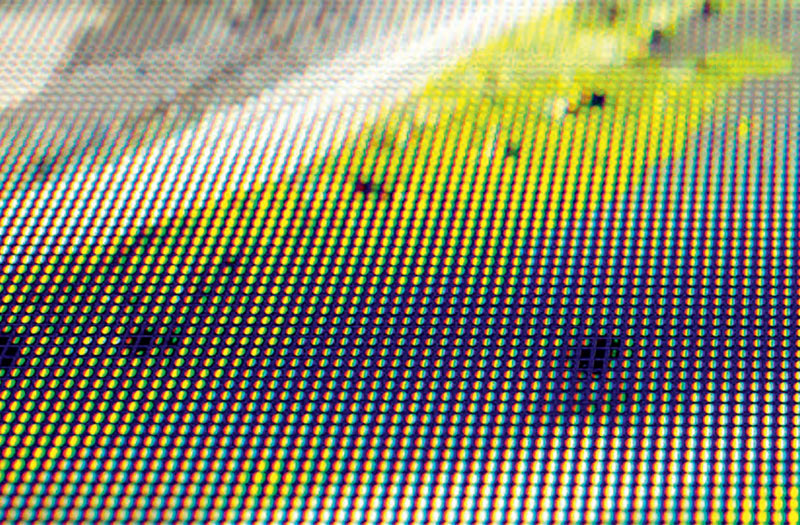
The call for entries was closed on April 1 with 705 applications from 78 different countries.
The international jury consisted of the Liedts-Meesen Foundation, Jean-Marie Dallet (artist and professor at the Université Paris 8), Stef Van Bellingen (artistic leader of WARP, Sint-Niklaas), Nick Ervinck (artist and winner of the public prize 2008), Yves Bernard (artistic director of iMAL Brussels), Alain Thibault (artistic director of ELEKTRA Montreal), Ralph Dum (scientific officer and senior expert of the European Commission) and Karen Helmerson (program director for Electronic Media, Film & Visual Art at New York State Council on the Arts (NYSCA)).
In May 2019 they selected the following 20 projects for the exhibition NTAA’19:
– Ran Ancor (IT) – Ku, the Void
– Sofian Audry and Monty Cantsin (CA) – The Sense of Neoism?! An Infinite Manifesto
– Ralf Baecker (DE) – Putting the Pieces Back Together Again
– Thijs Biersteker (NL) – Voice of Nature
– Kenny Wong Chi-Chuen (HK) – dist.duo
– Heather Dewey-Hagborg (US) – Probably Chelsea
– Emanuel Gollob (AT) – Doing Nothing with AI
– Daniel Jolliffe (CA) – Perfect View
– So Kanno and Yang02 (JP) – Asemic Languages
– Shinseungback Kimyonghun (KR) – Nonfacial portrait
– Greg Marshall (CA) – bearing
– Miranda Moss (ZA) – The Timid Wilderness
– onformative (DE) – Meandering River
– Matthew Ostrowski (US) – Summerland
– Marlene Reischl (AT) – Field
– Saša Spacal and Mirjan Švagelj (SI) – Meta_bolus
– Studio Jol Thomson (CA) – Deep Time Machine Learning
– Noriyuki Suzuki (JP) – Oh my ( )
– Tehran Platform (IR) – Wellograph
– Fabien Zocco (FR) – Game over and over
LAUREATS NTAA’19
Public Award
495 visitors casted a valid vote. The following five projects received 30 votes or more:
– ’The Timid Wilderness’ by Miranda Moss (ZA) (139)
– ’Doing Nothing With AI’ by Emanuel Gollob (AT) (69)
– ’Perfect View’ by Daniel Jolliffe (CA) (54)
– ’Probably Chelsea’ by Heather Dewey-Hagborg (US) (34)
– ’bearing’ by Greg Marshall (CA) (33)
“’The Timid Wilderness’ is an immersive, interactive installation comprising a luminescent jungle of shy flowers. The flowers are sensitive to sounds, especially those of humans ; they hide away when the noise level is too high, but bloom when silence is restored. Inspired by pollinating insects being able to detect patterns on flowers that are only visible in the UV spectrum, the piece imagines what this supernatural, glowing world might look like, and questions the way in which we communicate with our natural surroundings. While the work is playful to interact with and visually decadent, a darker undertone lingers on the destructive abilities of humankind and how they impact the planet. Largely fabricated from recycled materials, the piece aims to teach children ideas about ecology and technology working in equilibrium, particularly aiming to introduce ideas such as biomimicry in a playful way.”
Jury Award
All eight international judges announced their judgement. Six projects received six points or more:
– ’Probably Chelsea’ by Heather Dewey-Hagborg (US) (13)
– ’Perfect View’ by Daniel Jolliffe (CA) (10)
– ’Putting the Pieces Back Together Again’ by Ralf Baecker (DE) (8)
– ’Nonfacial Portrait’ by Shinseungback Kimyonghun (KR) (7)
– ’Summerland’ by Matthew Ostrowski (US) (6)
– ’Asemic Languages’ by So Kanno and Yang02 (JP) (6)
“’Probably Chelsea’ consists of 30 different possible portraits of Chelsea Manning algorithmically generated by analysis of her DNA. Genomic data can tell a multitude of different stories about who and what you are. ’Probably Chelsea’ shows just in how many ways your DNA can be interpreted as data, and how subjective the act of reading DNA really is. ’Probably Chelsea’ pushes this even further by presenting thirty different variations on Chelsea’s portrait, suspended as a crowd at an assortment of human heights. The form of the installation was inspired by conversations Chelsea and Heather Dewey-Hagborg had about the limits of DNA profiling, along with the incredible mass movement that advocated for her release from prison. ’Probably Chelsea’ evokes a kind of DNA solidarity, on a molecular level, we are all Chelsea Manning. Each genomic variation is a piece of data, a new clue and another possible story. As more data is put together, some things become more probable, and some less, but there is never certainty and there are always alternate possible narratives. ’Probably Chelsea’ portrays these alternate narratives and represents a sampling of the many stories Chelsea’ DNA can tell.”
The project received a positive appreciation from three judges. The proposed work responds to the requirements of the competition and its rules concerning the aesthetic use of new technologies, in response to contemporary values.
Award in collaboration with the STARTS-program of the European Commission
This award goes to Putting the Pieces Back Together Again by Ralf Baecker (DE).
“The kinetic installation ‘Putting the Pieces Back Together Again’ is a complex system with self-organizing and emergent behavior. At the same time it is an artistic research and meditation on contemporary scientific methodology. The installation investigates non-hierarchical communication and collective behavior by converting such a system into numerous electromechanical actors. ’Putting the Pieces Back Together Again’ consists of 1250 stepper motors arranged in a two-dimensional grid. Each motor is equipped with a pointer made from acrylic glass. The radii of the pointers are chosen to intersect with the pointers of their neighbours. In the event of a collision, the pointers reverse their turning direction. Through the interplay of many entities, a complex behaviour emerges on the surface of the installation that’s forming spontaneous patterns. By manipulating the signals during runtime it seems like the pointers are negotiating their positions. ’PTPBTA’ acts as an epistemological instrument to look at dynamics that emerge from non-hierarchical and collective organisations including social systems, economics, climate system and biology.”
Ralph Dum: “The work of Ralf Baecker is a reflection on interaction and emergence. A number of identical parts (the chips and actuators in each pointer) create a system that is behaving randomly, chaotically.”
Each artist of the winning project is awarded with a cash prize of € 5000.
Update_7 (2019)
Update_7 / Mémoires Vives took place from from January 12 to March 10 in Zebrastraat Ghent and the Centre for Fine Arts Brussels.
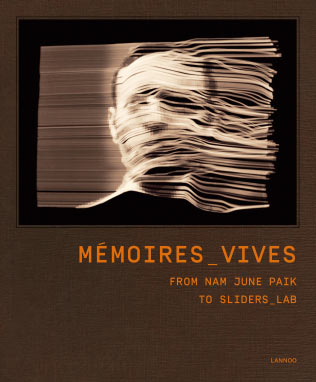
Curator: Jean-Marie Dallet
The video art appeared in the second half of the 1960s. This art form is related to the official television with which, however, it does not share the commercial side, aesthetic finality or manner of dissemination. The pioneers of the video art wanted, under the impulse of Korean artist Nam June Paik, to blow up the aesthetic limits of traditional art, using the technology of which the product was more communicative than an individual artwork. Video art was born from an interest in the intangible message of electronics as distinct from the static physical forms of traditional plastic arts. The activity of these artists emphasizes the following concepts: power, mass media, television, broadcast, signal, technique. These concepts will occupy a large part of the artists’ activities, opening new intellectual horizons in which some saw the birth of a new episteme. This idea of a changing world, which has led to a new intellectual era since the 1960s, is especially interesting because it parallels with the reflections that could be heard in the early 1990s when the computer became ‘personal’, i.e. accessible for everyone.
The exhibition wanted to show that these two moments, that of the 1960s and that of the 1990s, cannot be seen apart from each other but are connected by secret ties. To begin to draw these ties the following three axes were followed:
1 - devices, their use and their invention by artists;
2 - the memory and thus the archive;
3 - the multiplicity of screens as the construction of a new mental universe.
To explore these relationships between two worlds, one analogue and the other digital, the exhibition presented about fifteen installations, video films, sculptures, photographs, generative works and archival documents. Some of the works presented are considered as milestones of contemporary art.
After an inaugural session with the artists on the day of the opening, conferences were held regularly every Thursday for the duration of the exhibition. They allowed the audience to discuss with leaders of cultural institutions, theoreticians, researchers and artists the questions raised by the exhibition. Artists that participated for the inaugural session: Steina and Woody Vasulka (subject), Frédéric Curien (collective SLIDERS_lab), René Sultra and Maria Barthélémy and Jinsuk Suh, director of the Nam June Paik Art Center, South-Korea.
Intended speakers: Thierry Dufrêne (university professor, university of Nanterre, France); Larisa Driansky (Maitre de conférences, university of Paris 1 La Sorbone); Anne-Marie Duguet (university professor emeritus, university of Paris 1 La Sorbone, France); Don Foresta (director of the MARCEL Foundation, former director of the American Cultural Center in Paris, France); Patrick Nardin (Maitre de conférences, university of Paris 8 Vincennes, France); Grégoire Quenault (Maitre de conférences, university of Paris 8 Vincennes, France); Joost Rekveld (artist, Amsterdam, Netherland); Halldor Runolfsson (former director at the National Gallery of Iceland, Iceland); Jeffrey Schier (engineer, creator with W. Vasulka of the Digital Images Articulator, CA, USA); SLIDERS_lab (collective of artists, Angoulême, France).
On Thursday 17th January a concert was given by SPECTRA paying tribute to Paik’s Fluxus-past with i.a. a selection from George Maciunas’ ’Twelve Piano Compositions for Nam June Paik’. Fluxus was a rather loose grouping of artists who were looking for the blending of art forms and disciplines, often using new media. The German artist Michael Beil showed in String Jack how these ideas about intermedia can be shaped today. Image and sound, past and present mingled with a surprising saturation: the daily abundance of information artfully queried. In this context, house composer Joris Bahru also formulated his answer in a special creation.
Participating artists
Maria Barthélémy & René Sultra
Sultra&Barthélémy have been collaborating since 1992. They developed already in a very early stage a toolbox made of small programs and micro-mechanical items working on the time of the image. Their latest project, RétinA, is bridging old and new technologies by exploring the imaging potential of a woven screen. This new connected textile matrix limited to very low definitions requires them to rethink the images, to understand the field, to grasp the thresholds and visibility codes.
Anne-Marie Duguet
Anne-Marie Duguet is Professor Emeritus at the University Paris 1 Panthéon-Sorbonne and art critic, author and curator. Since 1995, she has directed the anarchive collection, a multimedia monographic archive on contemporary art, dedicated to Antoni Muntadas, Michael Snow, Thierry Kuntzel, Jean Otth, Fujiko Nakaya, Masaki Fujihata and Peter Campus. www.anarchive.net
Nam June Paik
Nam June Paik (Seoul, 1932), the ‘father of video art’, studied music and art history at the University of Tokyo. Paik was a pioneer in the use of televisual electronic media in art. His work consists of music, performances and media installations. He is known for making robots with televisions and the first video collages with found materials. He was a member of the Fluxus-movement and was influenced by artists like John Cage and Marcel Duchamp. In 1964 he moved to New York, and from 1965 he began to experiment with electromagnets and color tv, and later with video camera. Paik died in 2006 in Miami Beach.
SLIDERS_lab [F. Curien, J.-M. Dallet]
The SLIDERS_lab is a collective of artists who conducts experiments on new ways to design and realize artistically the shaping of large sets of information, to think plastically about the concept of aesthetics of the information in the era of big data. Their approach is multifaceted, ranging from installation, performance, design and experimentation. Their projects are characterized by their fictional dimension, their critical look, their freedom from codes and their ability to offer new experiences to the individual and collective body.
Steina and Woody Vasulka
Steina (°1940) and Woody Vasulka (1937 - 2019) live and work in Santa Fe, USA. They collaborate since their arrival in the US in 1965. She is musician, he engineer and filmmaker. By the end of the sixties, the Vasulka’s considered the manipulation of electromagnetic energy as a form of language. As early as 1969, their first experiments led them to build machines that could probe the process of creating the electronic image. In 1971, in New York, they created The Kitchen, a multidisciplinary alternative space and experimental site where many artists explore the possibilities of sound and image.
Joost Rekveld
Joost Rekveld is an artist motivated by the question what we can learn from a dialogue with machines. He explores the sensory consequences of systems of his own design, often inspired by forgotten corners in the history of science and technology. These systems combine temporary dogmata in the form of procedures or code, with more open-ended elements such as material processes or networks of interactions that are too complex to predict. His films, installations and performances are composed documentaries of the worlds opened by such systems. In their sensuality they are an attempt to reach an intimate and embodied understanding of our technological world.
Update_6 (2016)
The exhibition update_6 / NTAA 2016 took place from November 5th to December 4th, 2016 at Zebrastraat Ghent and the Centre for Fine Arts Brussels, Belgium.
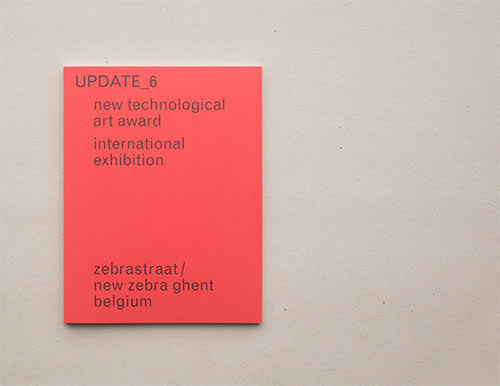
In reply to the call for projects for our international contest New Technological Art Award 2019, 487 candidates representing 59 nationalities worldwide have registered.
The selected projects for update_6 / NTAA 2016 were:
- 1024 architecture – François Wunschel, Jason Cook, Pier Schneider (FR) ‘WALKING Cube’
- Assocreation / Daylight Media Lab (AT/TH) ‘Solar Pink Pong’
- Alessio Chierico (IT) ‘Trāṭaka’
- CREW_Eric Joris (BE) ‘Collateral Rooms’
- Michiel De Cleene (BE) ‘Reference Guide’
- Dries Depoorter (BE) ‘Sheriff Software’
- Verena Friedrich (DE) ‘THE LONG NOW’
- Julien Grossmann (FR) ‘Breakaway Songs’
- Elias Heuninck (BE) ‘Lightkeeping’
- Michael Kugler (US) & Sebastian Wolf (DE) ‘Brume’
- Marc Lee (CH) ‘Pic-me’
- Michael Mandiberg (US) ‘Print Wikipedia’
- Quadrature – Jan Bernstein, Juliane Götz, Sebastian Neitsch (DE) ‘Satelliten’
- Theresa Schubert (DE) ‘Growing Geometries (Tattooing Mushrooms)’
- Karina Smigla-Bobinski (DE) ‘SIMULACRA’
- Maja Smrekar (SI) ‘K-9_topology: ECCE CANIS’
- Stanza (UK) ‘The Reader’
- Bill Vorn & Louis-Philippe Demers (CA) ‘Inferno’
- Lien-Cheng Wang (TW) ‘Regeneration Movement’
Work in dialogue: ’IVY2.0’ by Tom Dekyvere
The 19 nominated works were selected by an international jury: Head of the jury Martin Honzik (Head of Department Prix/Festival Ars Electronica) together with Peter Weibel (Director, ZKM Karlsruhe), Jean-Marie Dallet (Artist, research professor at the Université Paris 8), Liedts-Meesen Foundation, Stef Van Bellingen (Consultant for Zebrastraat – Artistic leader of WARP), Paul Dujardin (CEO & Artistic Director BOZAR), Nick Ervinck (Artist, winner of the update_2 public award), Alain Thibault (Artistic Director of ELEKTRA Montreal), Edwin Carels (Curator New Media exhibitions), Karen Helmerson (Program Director for Electronic Media, Film & Visual Art at the New York State Council on the Arts (NYSCA)) and Ralph Dum (Scientific officer and senior expert of the European Commission).
The nominees competed for the prize of the jury (€ 5000), the prize of the public (exhibition in an European museum) and a prize in collaboration with the STARTS-programme of the European Commission (residence in an industrial enterprise / research centre).
EXHIBITION LEE LEE NAM
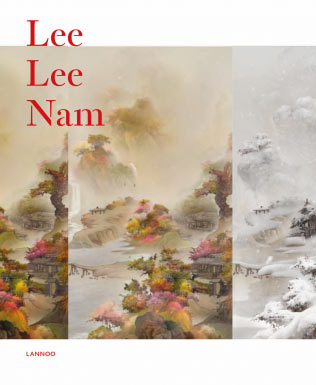 During the same period as update_6, Zebrastraat showed work of the South-Korean artist Lee Lee Nam. His works are located at the intersection of tradition and modernity, humanity and nature, East and West, analog and digital, originality and duplication and of neoliberalism and digital technology. Often referring to art history, he creates a dialogue between different traditional and modern media technologies and their cultural history. He lifts the barrier between diverse cultures and periods of time and questions the habits of perception and handling with art.
During the same period as update_6, Zebrastraat showed work of the South-Korean artist Lee Lee Nam. His works are located at the intersection of tradition and modernity, humanity and nature, East and West, analog and digital, originality and duplication and of neoliberalism and digital technology. Often referring to art history, he creates a dialogue between different traditional and modern media technologies and their cultural history. He lifts the barrier between diverse cultures and periods of time and questions the habits of perception and handling with art. IN COLLABORATION WITH BOZAR
Two artworks of NTAA were shown at BOZAR - Centre for Fine Arts Brussels
WINNERS NTAA 2016
Public Award
Of the 3,000 visitors, 384 casted a valid vote. The following five artists received 20 votes or more:
– 1024 architecture – François Wunschel, Jason Cook, Pier Schneider (FR) – ‘WALKING Cube’ (127)
– Verena Friedrich (DE) – ‘THE LONG NOW’ (32)
– Michael Kugler (US) & Sebastian Wolf (DE) – ‘Brume’ (32)
– Bill Vorn & Louis-Philippe Demers (CA) – ‘Inferno’ (28)
– Lien-Cheng Wang (TW) – ‘Regeneration Movement’ (23)
The public award consists of the presentation of the work, in the course of next year, at a major European cultural centre or museum. This award went indisputably to the artists collective 1024 architecture with their work ‘WALKING Cube’. “The ‘WALKING Cube’ is an erratic structure, a simple cube brought to life by a series of mechanical agitations. When animated, it becomes a basic shape turned animal. Performing with twerks and tweaks, it grows and it shrinks, it folds and kinks. The ‘WALKING Cube’ is the result of a collaborative research exploring physical movement. With the use of air-powered mechanics a composition of diverse transformations is prepared and executed with brutal force. It’s a demonstration presenting the chaotic possibilities in the deconstruction of a common and minimal form.”
Jury Award
Of the eleven international judges, eight have announced their judgment. Four artists received eight points or more:
– Michael Kugler (US) and Sebastian Wolf (DE) – ‘Brume’ (14)
– 1024 architecture – François Wunschel, Jason Cook, Pier Schneider (FR) – ‘WALKING Cube’ (9)
– Bill Vorn & Louis-Philippe Demers (CA) – ‘Inferno’ (8)
– Quadrature – Jan Bernstein, Juliane Götz, Sebastian Neitsch (DE) – ‘Satelliten’ (8)
The jury award thus went to Michael Kugler (US) and Sebastian Wolf (DE) – ‘Brume’, who are awarded with the price of 5,000 EUR.
“Inspired by an encounter with dense, low-hanging mist in a natural landscape, fog emerges and self-organizes on the surface of a sculptural element, congealing with light into an elusive strata. The viewer becomes a catalyst for disturbances, revealing the spatial and temporal volatility of this phenomenon. ‘Brume’ operates in the margins between ubiquity and the finite, symmetry and the amorphous, transience and permanence; a gesture and poetic reflection on the paradox of immateriality.” The artists received a positive appreciation from four different judges. The proposed work responds to the requirements of the competition and its rules concerning the aesthetic use of new technologies, in response to contemporary values.
Award in collaboration with the STARTS-program of the European Commission
This award, consisting of a residence at an industrial enterprise or research centre, went to the project ‘Growing Geometries (Tattooing Mushrooms)’ by Theresa Schubert (DE). “As an artistic research project, ‘Growing Geometries (tattooing mushrooms)’ investigates how processes inscribed into biological organisms can be used to create art – or more general a creative output. By using fungi membrane the artist studied the topology of mushrooms growths and showed how geometries can change naturally. The fungus is, therefore, not only the artist’s canvas, but also an artist itself.”
Update_5 (2014)
Update_5 (08/11/2014 – 23/11/2014) showed besides the 20 nominated artworks, also a new section consisting of the selection, by specialists from various sectors, of key works from the art world, scientific discoveries or innovative breakthroughs that have significantly changed our living and thinking habits. These objects or concepts formed the basis for a separate presentation and perception, while interacting with the works of the NTAA nominees.
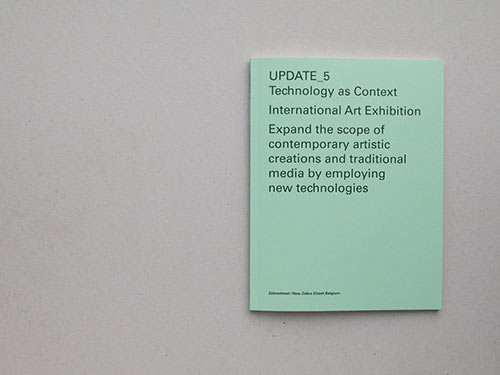
In reply to the call for projects for the international contest ‘New Technological Art Award 2014’, 383 candidates representing 50 nationalities worldwide have registered. The twenty nominated works were:
Nurit Bar-Shai (IL) ‘Objectivity [tentative]: Soundscapes series’
JD Beltran (US) + Scott Minnemann (US) ‘Cinema Snowglobe’
Jo Caimo (BE) ‘InnerRhythms’
Martin John Callaman (UK) ‘Departure of All’
Mattia Casalegno (IT) ‘RBSC.01’
Mats Dekock (BE) ‘Reconstructing Mariënbad’
Alisa Goikhman (IL) ‘LangWidgets’
Bart Hess (NL) ‘Digital Artefacts’
Beverley Hood (UK) ‘Glitching’
Karl Jeron (DE) ‘Hermes Opera’
Nandita Kumar (IN) ‘eLEMenT:EARTH’
Ebru Kurbak (TR) + Irene Posch (AT) ‘The Knitted Radio’
Keith Lam (HK) ‘One Day Social Sculpture’
LIA, (AT) ‘Filament Sculptures’
Dave Murray-Rust (UK) + Rocio von Jungenfeld (DE) ‘Lichtsuchende’
Stéfan Piat (FR) ‘Isola’
Quayola (IT) ‘Captives’
Stefan Tiefengraber (AT) ‘User Generated Server Destruction’
Jacob Tonski (US) ‘Balance From Within’
Patrick Tresset (FR) ‘5 Robots Named Paul’
Alex Verhaest (BE) ‘Temps Mort / Idle Times – Dinner Scene’
This jury was composed of: Idis Hartmann (Scientific Assistant Director of Prof. Peter Weibel of ZKM Karlsruhe), Jean-Marie Dallet (Artist and professor at the University of Paris 8), the Liedts-Meesen Foundation, Stef Van Bellingen (Consultant Zebrastraat - Artistic Director WARP), Paul Dujardin (Artistic Director BOZAR, Brussels), Nick Ervinck (Artist and winner of the Price of the Public of update_2), Julien Maire (Artist and winner of the Prize of the Jury of update_2), Alain Thibault (Artistic Director of ELEKTRA Montréal), Martin Honzík (Head of Department Prix / Festival Ars Electronica), Edwin Carels (Curator New Media exhibitions) and Patrick Allegaert (Artistic Director Museum Dr. Guislain).
JURY AWARD
Of the 10 international judges 9 have announced their judgment. Five artists received more than 8 points:
1. Quayola (IT) ‘Captives’
ex aequo Jacob Tonski (US) ‘Balance From Within’
3. Patrick Tresset (FR) ‘5 Robots Named Paul’
4. Nurit Bar-Shai (IL) ‘Objectivity [tentative]: Soundscapes series’
ex aequo Stefan Tiefengraber (AT) ‘User Generated Server Destruction’
The jury award thus went to two artists:
Quayola (IT) ‘Captives’
Jacob Tonski (US) ‘Balance From Within’
Exceptionally the price of 5000 euros was awarded to both artists.
‘Captives’ – Quayola : “’Captives’ is an ongoing series of digital and physical sculptures, a contemporary interpretation of Michelangelo’s unfinished series ‘Prigioni’ and his technique of ‘non-finito’. The classic figures are left unfinished, documenting the very history of their creation and transformation. Industrial computer-controlled robots sculpt the resulting geometries into life-size ‘unfinished’ sculptures’.”
‘Balance From Within’ – Jacob Tonski : “A 170 year old sofa balances precariously on one leg, continuously teetering, responding internally to external forces. Relationships are balancing acts, and delicate ones at that. This idea turned into a balancing sofa as Tonski was thinking about how all of our social interactions can take place on these pieces of furniture.”
Both artists received a positive appreciation from four different judges. The proposed works respond to the requirements of the competition and its rules concerning the aesthetic use of new technologies, in response to contemporary values.
Of the more than 2,000 visitors 525 casted a valid vote. The following five artists received more than 30 votes:
1. Patrick Tresset (TR) ‘5 Robots Named Paul’
2. Jacob Tonski (US) ‘Balance From Within’
3. Dave Murray-Rust (UK) + Rocio Von Jugenfeld (DE) ‘Lichtsuchende’
4. Bart Hess (BE) ‘Digital Artefacts’
5. Stefan Tiefengraber (AT) ‘User Generated Server Destruction’
The public award consists of the presentation of the work, in the course of 2015, at a major European cultural centre or museum. This award went indisputably to the artist Patrick Tresset with his work ‘5 Robots Named Paul’. “In a scene reminiscent of a life drawing class, the human takes the sitter’s role to be sketched by five robots. The drawing sessions last up to 40 minutes, during which time the human cannot see the drawings in progress. The sitter only sees the robots alternating between observing and drawing, sometimes pausing. The human sitter is passive, the robots taking the creative sensitive role.”
In addition to the works of the NTAA, several key works were displayed at Zebrastraat coming from the world of art, of scientific discoveries or breakthrough innovations that have significantly changed our way of living and thinking. These objects or concepts form the basis for a separate presentation and perception, in dialogue with the artworks of the nominees of the NTAA. The participating artists were Nick Ervinck (BE) 3D print ‘LUIZAERC’, Didier Faustino (FR) ‘Love me tender 2000’, FRONT404 (NL) ‘Eyestalkers’, Bart Prinsen (BE) ‘The world [dis]appearing on level_3’, LAb[au] (BE) ‘Chrono’.
Update_4 (2012)
The 4th update biennial proposes an exhibition radically different from the 3 previous editions: for the first time, it is taking place in 2 cities (Ghent and Brussels) and at 3 venues (Zebrastraat, iMAL and La Cambre) and it is exclusively focused on the 20 nominees of the New Technological Art Award 2012 in order to emphasize the actual dynamic of contemporary art creation in our technological world.
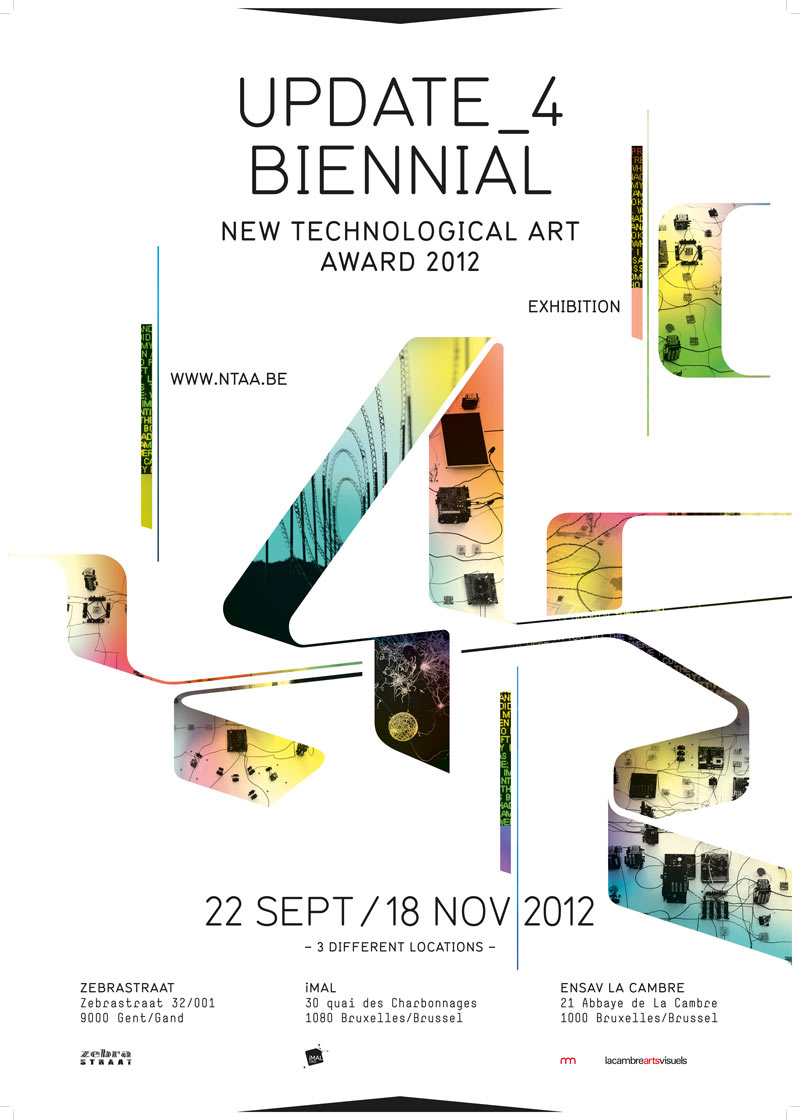
At the occasion of the fourth biennale for contemporary technological art in the Zebrastraat, Ghent, Belgium, and iMAL, La Cambre, Brussels, the New Technological Art Award of the Liedts-Meesen Foundation went to the work ‘Nihil Ex Nihilo’ of Félix Luque Sánchez, for which he receives 5 000 euros. The public awards went ex aequo to Wim Janssen with ‘Static’ and Julijonas Urbonas for ‘Euthanasia Coaster’. These artists were selected from 337 entries from 40 different countries worldwide by an international jury consisting of Jean-Marie Dallet (Professor and curator update_1), Alain Liedts (Chairman of the Liedts-Meesen Foundation), Dirk De Wit (Director of BAM, Flemish Institute for visual, audiovisual and media art), Stef Van Bellingen (Consultant for Zebrastraat - Artistic director WARP), Nick Ervinck (Artist and winner of the update_2 public award), Julien Maire (Artist and winner of the update_2 jury’s award), Yves Bernard (Founder of the art organisation iMAL) and Pierre-Yves Desaive (Professor at La Cambre, art critic Flash Art, L’Art Même, and art historian at KMSKB-MRBAB).
Update_4: Prize of the Jury
‘Nihil ex Nihilo’ by Félix Luque Sánchez (SP) was the winner elected by the jury of the 2012 NTAA. With this work, Félix Luque continued his exploration around machine intelligence and themes typical of science fiction that he started with his previous installation ‘Chapter I: The Discovery’. He developed an original formal expression, hybrid between installation and narration, where the visitor is invited to progress through a succession of spaces. The work plays with many modes of expression, from audiovisual, sculptural, computational to narrative ones. It is a complex but relevant integration of techniques (3D animation, text to speech, AI, electronic, network processes, digital manufacturing,...) to raise issues about the nature of intelligence and the fate of intelligent creatures.
Update_4: ex aequo public prices
Julijonas Urbonas ‘Euthanasia Coaster’
The Lithuanian artist Julijonas Urbonas could expect that there would be some reaction to his design, but not to that spectacular extent : at peak times his website had over 20,000 hits per day, and that for a scale model of a roller coaster. ‘Euthanasia Coaster’ is a (minutely calculated, real and feasible) design of a roller coaster in which people can put an end to their life with "elegance and euphoria". The contemporary problem of overpopulation, suicide and euthanasia which divides our society, is at the basis of this design. The artist does not make any ethical judgment, for or against, but through the aesthetics he examined the possible conditions under which through the kick of g-forces and euphoric moments, one could arrive in the afterlife. ’Euthanasia Coaster’ seems a radical consequence of our entertainment society that needs existential reflection.
Wim Janssen ‘Static’
Wim Janssen studied experimental film and video at the Sint-Lukas in Brussels. ‘Static’ is a spatial installation in which, using simple means, the phenomenon of noise or a snowy image on a television is visualized. We know this phenomenon when, by the distance, a fading or loss of signal occurs. Using tiny plexi panels, the precise placement in space, movement, rotation, the light angle and polarization, Janssen recreates this remarkable artefact of the technology. Not only the iconic image itself, but also the manual way it is obtained, made a fierce impression on the visitors.
Colloquium ’Immortal’
Following the exhibition update_4 in Zebrastraat in Ghent, the art school La Cambre and iMAL in Brussels, a colloquium was organized around the theme "immortal" in art. Museum directors, restaurateurs, philosophers, artists and scientists reflected on the physical and symbolic survival of artworks and more specifically computer-related or technological art. It is clear that the traditional paradigms concerning preservation and conservation are under pressure. This raises new questions about what can and should be preserved. Through the realization of ’scores’, which act as a guide, it becomes possible to reproduce an artwork, and consequently the concept of authenticity gets a new interpretation. The results of this three day colloquium were published online with text and moving images.
Update_3 (2010)
Update_3/ Body Sound (17/04/2010 – 20/06/2010), under the artistic direction of Christine Van Assche, in turn, put a unique emphasis on sound, with a selection of works from the New Media Department of the Centre Pompidou. For the second time a contest under the banner of the New Technological Art Award of the Liedts-Meesen Foundation was organized, with a presentation of 10 artworks.
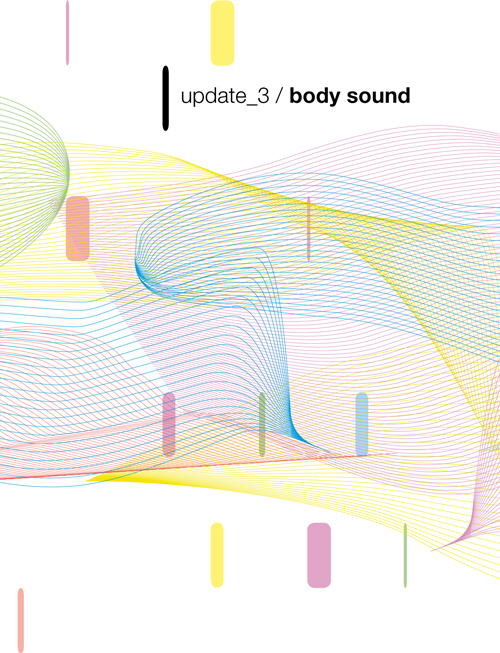
Update_3/ Body Sound is an exhibition by the New Media Department of Centre Pompidou, designed by the Bureau des Mésarchitectures in Paris, and realized by the Zebrastraat, at the initiative of the Liedts-Meesen Foundation, under the artistic direction of Christine Van Assche. Sound works were selected from the collection of the New Media Department. The challenge was to present a history of sound in the arts. Big names in contemporary art such as Bruce Nauman, Vito Acconci, Manon de Boer, Céleste Boursier-Mougenot, Carsten Nicolai - Alva Noto, Anouk De Clercq, Didier Faustino, Mike Kelly / Scanner, Martin Creed, Adam McEwen, Keiko Owada, Mika Vainio, Chris Marker, Ugo Rondinone, Emmanuel Lagarrigue and Semiconductor were presented next to and between one another along the exhibition circuit. The architects of the Bureau des Mésarchitectures, Paris made a special scenography.
For the second time a contest was organized under the name of the New Technological Art Award of the Liedts-Meesen Foundation, with a presentation of 10 works. The artists were selected from 264 entries from over 45 different countries. The international jury consisted of Peter Weibel (ZKM Karlsruhe Director), Jean-Marie Dallet (Paris 8 University Professor and curator update_1), Philippe Van Cauteren (Director S.M.A.K., Ghent), Françoise Meesen (Liedts-Meesen Foundation), Dirk De Wit (Director BAM - Institute for visual, audiovisual and media art), Stef Van Bellingen (Consultant Zebrastraat / Artistic director WARP ), Christine Van Assche (Curator of New Media Centre Pompidou, Paris), Art Yan (Exhibition Organiser E-Arts Festival, Shanghai), Nick Ervinck (Artist, winner of the public prize update_2), Julien Maire (Artist, winner of the prize of the jury update_2).
The following 10 artists were nominated:
Perry Bard (US) ‘Man With A Movie Camera: The Global Remake’
Félix Luque Sánchez (ES) ‘Chapter I: The Discovery’
Boris Debackere (BE) ‘Probe’
Peter Alwast (AU) ‘Everything’
Peter Beyls (BE) ‘Petri’
Dominika Sobolewska (PL) ‘RGB (Red-Green-Blue)’
Go Eun Im (KR) ‘SEE(N)’
Christoph De Boeck (BE) ‘Staalhemel’
Arthur Elsenaar (NL) ‘Face Shift’
Julien Gachadoat (FR) ‘Gravity’
The jury award of 5000 euro was handed over on Sunday, June 20, 2010 to Julien Gachadoat (FR) for his work ‘Gravity’, a shared audience award went to ‘Gravity’ and ‘SEE(N)’ of Go Eun Im (KR). Motivation by the jury its choice of ‘Gravity’.
Julien Gachadoat winner of the New Technological Art Award Foundation Liedts Meesen-2010
With ‘Gravity’ the jury chooses an interactive real-time system merging architecture, telephony and typography. The viewer can send a text message, which is then projected onto a wall, in order to establish a poetic dialogue between architecture and audience. In a unique and surprising way and with a special appeal Julien Gachadoat knows to guide the texts formally and visually in their track.
An ex aequo public prize was awarded to ’Gravity’ by Julien Gachadoat and ‘SEE(N)’ by Go Eun Im. The South Korean Eun Im Go knows how to charm the audience with her personal view on looking and remembering. The interactive work ‘SEE(N)’, to see and to be seen, directs our gaze towards an inventive and artistic mania.
Update_2 (2008)
The edition update_2/ Selection ZKM (20/04/2008 – 06/07/2008) was a collaboration with director Peter Weibel of ZKM (Zentrum für Kunst und Medientechnologie) in Karlsruhe (DE) and Stef Van Bellingen (BE) as co-curator. In update_2 several works from the ZKM collection were exhibited, and for the first time the competition New Technological Art Award was organized. Parallel to the ZKM exhibition 12 works were nominated chosen between more than 70 entries displayed on the site of the Zebrastraat in Ghent.
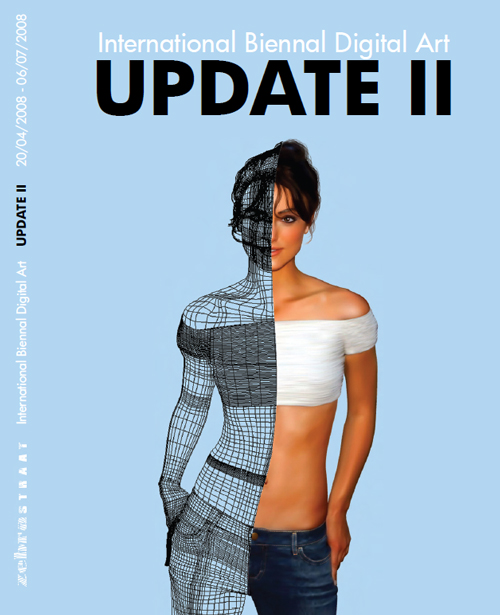
Update_2 presented masterpieces from the ZKM collection by Jim Campbell, Heinz Mack, Piero Fogliati, Bruno Munari, Kovac Architecture, Masaki Fujihata, Golan Levin, Wolfgang Münch, Jeffrey Shaw, Tony Oursler and Bruce Nauman. Esther Polak, Michell and Jean-Pierre Hartmann produced new work for the Zebrastraat. The exhibition was accompanied by a comprehensive program of films, molecular cooking, lectures, debates, a concert, ...
An international jury selected the various art projects on Tuesday, January 29, 2008 from the entries representing 16 different countries (Belgium, the Netherlands, France, Germany, Great Britain, Switzerland, Austria, Romania, Slovenia, Japan, Israel, USA, New Zealand, Canada, Brazil, Paraguay, ...). The jury consisted of Jean-Marie Dallet (Professor and curator update_1) - Philippe Van Cauteren (Director S.M.A.K. Ghent) - Françoise Meesen (Liedts-Meesen Foundation) - Dirk De Wit (Director BAM) - Stef Van Bellingen (Consultant Zebrastraat / Artistic director WARP ) - Esther Polak (artist – Laureate of Ars Electronica Linz 2005).
The shortlisted artists were Juliana Borinski & P-L Cassière (BR/FR), Frederik De Wilde (BE), Kurt d’Haeseleer (BE), Nick Ervinck (BE), Wim Janssen (BE), Christoph Wachter & Mathias Jud (CH), Leroy + Leroy (FR), Julien Maire (FR), Christophe Meierhans (DE), OpenEndedGroup (US) and Janek Schaefer (UK).
The jury award of 5000 euros was handed over on Sunday, June 1, 2008 to Julien Maire (FR) for his work ’Exploding camera’, the public prize went to Nick Ervinck (BE) with ’Studies 2004-2006’. The installation ’Exploding Camera’ (2007) by Julien Maire (1969, Metz, FR) was selected by Philippe Van Cauteren for presentation at the S.M.A.K. (Museum of Contemporary Art) in Ghent between 13/12/2008 and 22/02/2009.
Motivation by the jury for its choice of ’Exploding Camera’ Julien Maire:
’Exploding Camera’ is a spatial artwork based on an attack on Commander Massoud with a bomb camera in the period of 9/11. The jury had several motivations to acclaim this work:
- It links art to international politics and economics
- The intelligent use of technology
- The "media archaeology" (the processing of various film and pre-cinematic devices)
- Though the artwork seems to be an explosion in a space (a deconstruction), it is actually a construction of a somewhat forgotten reality.
- The perfect performance of the work, despite the fragile appearance
- The temptation for the visitor to unravel the work.
Julien Maire (from France but at that moment living and working in Berlin) responded very enthusiastically. There are already not so many prizes for artists who are not active in the more traditional media (painting or sculpture), but he is particularly pleased that the story of Commander Massoud will become better known outside France and Germany. The assassination of Massoud became the subject of French research journalism, and two years after his death, even a postage stamp with his portrait was made. As main leader of the anti-Taliban alliance, he is considered a national hero in Afghanistan. The technical means are for Julien Maire subordinated to the impact of the overall picture, and he also wants the viewer to comprehend the (manipulated) reality.
The public awarded the work of artist Nick Ervinck ‘Studies 2004-2006’. As a result of its selection the Liedts-Meesen Foundation gave the artist the opportunity to convert his computer-animated images into a larger than life installation. On the night of 28 on 29/07/2009 two identical but mirrored frame structures were placed on the roofs of Zebrastraat. The sculptures each are 12 meter long by 6 meter wide. The artwork, called ‘WARSUBEC’, was constructed in Venlo (NL) and transferred by special transport to Ghent.
Update_1 (2006)
The first exhibition update_1/ The origin, under the artistic direction of Jean-Marie Dallet, lecturer at the EESI (École Européenne Supérieure de l’Image in Poitiers (FR)) gave an overview of 30 interactive digital artworks that made use of new media in an innovative way.
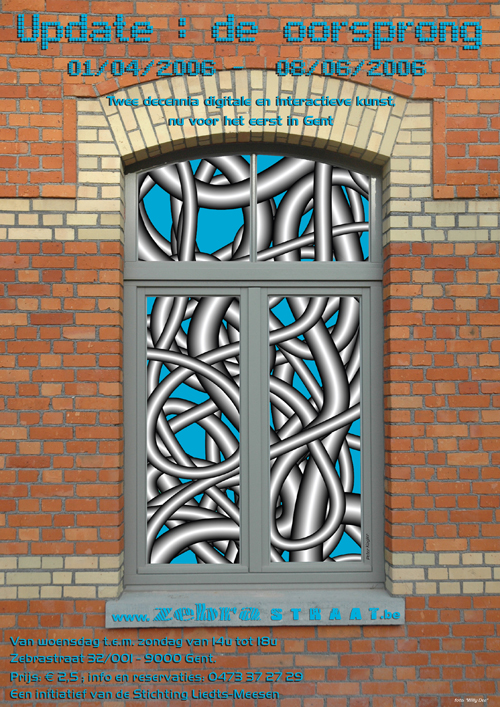
The exhibition showed work by the artists Peter Beyls, Jean-Louis Boissier, Anouk De Clercq, Edmond Couchot & Michel Bret, Chris Cunningham, François Curlet, Jean-Marie Dallet, Koen De Decker, Driessens & Verstappen, Masaki Fujihata, Jerry Galle, Tobias Grewenig, Thierry Guibert, Peter Kogler, Piotr Kowalski, Christian Laroche, William Latham, Sol LeWitt, Lia, Matt Mullican, David Renaud, Soda Play, Koen Theys, Erki de Vries.
Piotr Kowalski: a tribute - By way of tribute to artist / scientist Piotr Kowalski who deceased in 2004, a special room was set up during update_1 showing his work, which is constantly shifting between art and science. In Kowalski’s art, science is something close to humans, as a way to interact with the world around us.
Stippels & Pixels (2005)
The exhibition Stippels & Pixels (29/01/2005 – 10/04/2005), which considered the numeric aspect in the art, from pointillism to the pixel, provided the impulse for a biennial event in which actual and new technologies are used and implemented in a creative and meaningful way.
Stippels & Pixels is a discovery journey from the 19th-century pointillism to the present world of pixels. The starting point was partly obvious, as the entire Zebrastraat complex was realised by Charles Van Rysselberghe, brother of the artist Théo Van Rysselberghe, who was the most important representative of Neo-Impressionism in Belgium.
This art movement relied on scientific grounds, a factor that also propels our contemporary digital world. About forty works were shown in the brand new exhibition hall grouped in a few themes: dots as the basis of the imaging; the number behind things; image migrations; griding and telecommunication; multimedia and the return of the synesthesia.

